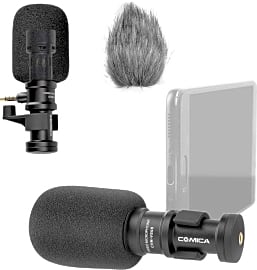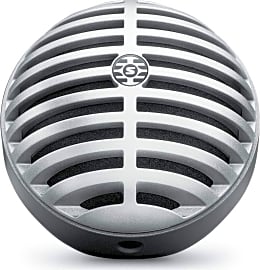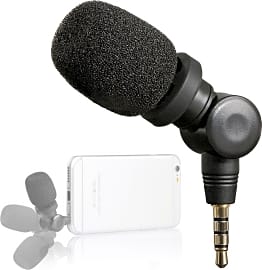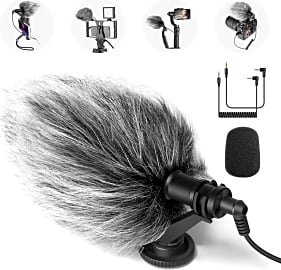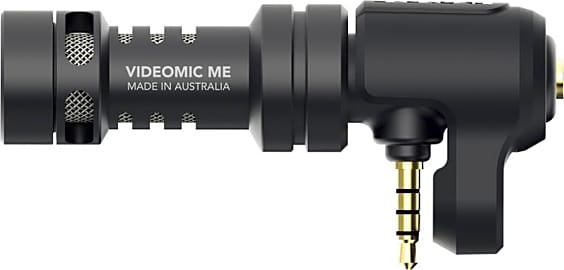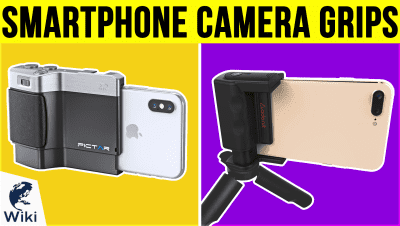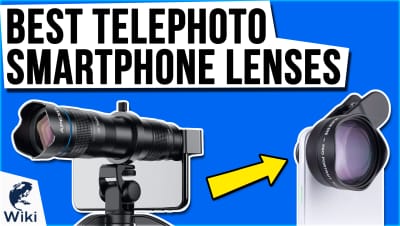The 10 Best Smartphone Mics

This wiki has been updated 39 times since it was first published in October of 2015. As if your mobile device didn't do enough already, it can now be your on-the-go recording studio using one of these mics, which capture much better audio than built-in microphones. Given that today's smartphones can record HD video in up to 4K, these additions can turn them into tiny A/V studios for DIY filmmakers, though you might need a dongle for phones lacking a jack for headphones. When users buy our independently chosen editorial choices, we may earn commissions to help fund the Wiki.
Editor's Notes
November 07, 2020:
Many of our original favorites remain on this updated list, as they’re proving dependable for those looking to boost sound recording capabilities on mobile phones. Types range from the reasonably priced, pocket-sized Saramonic Mini SmartMic, to the Shure MV88+, a sturdy little rig with a table tripod, which elevates your Zoom meetings or vlogging. We have replaced the Movo MA2010 with a more dependable mic, and removed the Apogee MiC 96k Professional, which was having fulfillment issues.
Comica manufactures quality sound equipment, so we’ve added another of their models to our list. The Comica CVM-WS50 is a lavalier mic appropriate for high-quality home video production, and we also like the Neewer CM14, despite that you’ll need an adapter if you’re using an iPhone. Don't want to bother with adapters? No worries, as there are lots of resources specifically for those who use iPhones for recording.
November 19, 2019:
You don't actually have to spend a fortune to get your hands on a good smartphone mic. Of course, if you do insist on the highest-quality recordings, be prepared to drop a considerable amount; the Shure MV88+ is often considered the best around, but it's awfully pricey, as is the Apogee MiC 96k Professional, which only works with Apple products. The Shure MV5 and Saramonic SmartMixer are a bit less expensive and don't have too much of a drop-off from the high-end units. In fact, the Saramonic is actually pretty cost-effective for a dual-mic stereo unit.
In the middle are a pair from Rode, the Rode VideoMic Me and Rode SmartLav+. The VideoMic is remarkably compact, but the SmartLav+, a traditional lavalier-style model, is a bit more consistent from user to user. If you plan on wearing the mic to capture dialog, it's an excellent choice.
On the less expensive side of things, you still have some great selections, as well. The Movo PR-2-PM includes a sturdy bracket, mount, and monopod handle, while the Comica CVM-VS08 comes in 3.5-millimeter and USB-C versions, and they're both reasonably priced. But if you're really on a tight budget and don't want something bulky to carry around, it's hard to beat the Movo MA2010 and Saramonic Mini SmartMic, both of which are as effective and affordable as they are compact. And if you want to make certain that your videos look as good as they possibly can, check out our selections of stabilizers, camera grips, and telephoto lenses.
Professional Quality Goes Mobile
The reason the microphones on this list are so superior to the mics built into smartphones has a lot to do with the size of their diaphragms.
If you've ever tried to track any kind of live audio with your smartphone, you know how disappointing the results often are. The sound is usually far too thin, far too roomy, and more or less unusable. With an apologetic disclaimer, you might be able to get away with it as stand-alone audio for a podcast or radio program, but paired with a video track, the quality of the entire experience will be irredeemable.
The reason the microphones on this list are so superior to the mics built into smartphones has a lot to do with the size of their diaphragms. Any microphone has a little piece inside of it that senses the vibrations in the air created by a litany of sounds. The microphone then internally translates those vibrations into an electrical signal which is then converted into a digital binary passed into a processor in the phone's sound card.
That's a lot of difficult computing being done with very small apparatuses, and it turns out, in this case at least, that size matters. Larger areas of sensitivity from a larger microphone's diaphragm, as well as more processing power devoted to the translation of the sound into and out of its digital format will result in a higher quality audio.
Essentially, these are all professional quality microphones that have acquired the wiring necessary to communicate with the software and hardware they encounter when plugged into a given smartphone. Rewire any of them to fit into a different kind of transmitter or amplifier, and you'd never know the difference between these and their professional counterparts.
The Most Versatile Options
It's more than likely, if you're here researching these smartphone mics, that you intend to couple the audio they capture with video, whether or not you use the phone itself to capture said video.
I've used smartphone lavaliere mics (aka lavs) dozens of times to track audio for films, hosting segments, interviews, and more, and they almost always get the job done. The small stereo and shotgun mics you can mount on the phones are equally excellent for capturing subjects that are close to the mic itself, but they don't do great work across a distance, since they simply aren't long enough to build a sufficient polar pattern for true shotgun use.
A well-hidden lav mic usually spends its recording time buried under layers of clothing, and any movement by the wearer translates into unusable sound.
Then, you have the more traditional vocal-style mics on the list, which are ideal for picking up a single speaking or singing voice, but don't do much good to you if you're doing on-the-fly documentary work, for example.
All of this comes down to a simple question: what are you trying to track? More often than not, if you're doing any kind of film work where you want to use the phone to track audio only and capture the video through a professional camera or even a separate smartphone, lavs will be your best bet.
Their size makes lavs easy to hide on an actor, a host, or an interviewee, and, since they plug right into your cell phone, you can have the person wearing the mic simply put the phone in his or her pocket, and nothing will look out of the ordinary. That is, unless you're filming a period piece that takes place before cell phones existed. Then, you might need to throw in a line of dialogue about how all the characters like carrying around decks of cards or something.
The one major downside to the lavs, however, is the threat of clothing rustle. A well-hidden lav mic usually spends its recording time buried under layers of clothing, and any movement by the wearer translates into unusable sound. There are additional implements out there designed to cut down on this phenomenon, some of which work much better than others, so check those out if you want to keep things professional.
Condensing Years Of Discovery
The desire to amplify the human voice spurned on the invention of the microphone before any thought of using such a device for recording its sound surfaced. Early attempts at amplification could more easily be classified as primitive megaphones than microphones.
The old tin can and string method was the next development in the technology, first arriving 2,200 years after the Greek masks.
These were the dramatic masks worn in Greek antiquity by actors in the nation's famous amphitheaters. They had small protruding beaks that increased the vibrational resonance of an actor's voice to throw it farther out across an audience.
The old tin can and string method was the next development in the technology, first arriving 2,200 years after the Greek masks. Then, Alexander Graham Bell's telephone came along, using a diaphragm suspended in an acid solution to transmit the vibrations of the human voice across an electrified distance.
A year or so later, in 1877, David Edward Hughes had his loose-carbon microphone design stolen and patented out from under him by none other than that scoundrel Thomas Edison. A long legal battle ensued, which Edison won, and the microphone set forth on its path toward modernity when, in 1916, the first condenser microphone (the technology on which all the microphones on this list are based) finally hit the scene.



